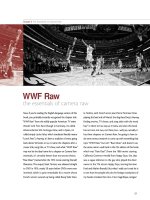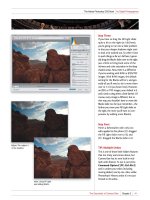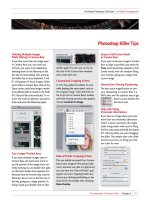The Adobe Photoshop CS5 Book for Digital Photographers part 11 docx
Bạn đang xem bản rút gọn của tài liệu. Xem và tải ngay bản đầy đủ của tài liệu tại đây (1.29 MB, 10 trang )
ptg
81Chapter 3Camera Raw—Beyond the Basics
The Adobe Photoshop CS5 Book for Digital Photographers
Step Three:
So now the Blues are bright, but they’re
not rich and bold yet, so click on the
Saturation tab near the top of the panel,
and then drag the Blues slider all the
way over to the right, and the sky just
comes alive with color. I also dragged the
Aquas slider to the right, too (as shown
here), because it had such a great effect
on the sky earlier, and I dragged the Reds
slider to the right to bring out the red in
the sculpture. Now that the photo is real-
ly vivid, you may see some unintentional
edge vignetting in the corners, so just go
to the Lens Corrections panel, click on the
Manual tab and, under Lens Vignetting,
drag the Amount slider to the right until
it goes away (for me, it was about +26,
and I didn’t need to touch the Midpoint
slider at all. See page 74 for more on
fixing vignetting).
Step Four:
To actually change colors (not just adjust
an existing color’s saturation or vibrance),
you click on the Hue tab near the top
of the panel. The controls are the same,
but take a look at the color inside the slid-
ers themselves now—you can see exactly
which way to drag to get which color.
In this case, to make the red sculpture
yellow, you’d drag the Reds and Oranges
sliders to the right. Easy enough. To make
the sculpture orange, drag the Reds slider
to +79, drag the Oranges slider to –32,
and the Yellows slider over to –100. How
did I figure this one out? You guessed it—
I started dragging sliders around (don’t
tell anybody I actually do this).
Download from www.wowebook.com
ptg
82
Chapter 3 Camera Raw—Beyond the Basics
The Adobe Photoshop CS5 Book for Digital Photographers
Step One:
This photo has some simple problems
that can be fixed using Camera Raw’s
Spot Removal tool. You start by clicking
on the Spot Removal tool (the seventh
tool from the right in the toolbar) or by
pressing B to get it, and a set of options
appears in the Spot Removal panel on
the right (seen here). Using the tool is
pretty simple—just move your cursor
over the center of a spot that needs to
be removed (in this case, it’s those spots
in the sky where my camera’s sensor
got dirty), then click, hold, and drag
outward, and a red-and-white circle
will appear, growing larger as you drag
outward. Keep dragging until that circle
is a little larger than the spot you’re trying
to remove (as shown here below). Don’t
forget, you can use the Zoom tool (Z)
to zoom in and get a better look at your
spots before you drag out your circle.
Removing
Spots, Specks,
Blemishes, Etc.
If you need to remove something pretty minor from your photo, like a spot
from some dust on your camera’s sensor, or a blemish on your subject’s face,
or something relatively simple like that, you can use the Spot Removal tool right
within Camera Raw. If it’s more complicated than just a simple spot or two, you’ll
have to head over to Photoshop and use its much more powerful and precise
retouching tools (like the Healing Brush tool, Patch tool, and Clone Stamp tool).
SCOTT KELBY
Download from www.wowebook.com
ptg
83Chapter 3Camera Raw—Beyond the Basics
Continued
The Adobe Photoshop CS5 Book for Digital Photographers
Step Two:
When you release the mouse button,
a second circle (this one is green and
white) appears to show you the area
where Camera Raw chose to sample
your repair texture from (it’s usually
very close by), and your spot or blemish
is gone (as seen here).
TIP: When to Fix Blemishes in
Camera Raw
So, what determines if you can fix a
blemish here in Camera Raw? Basically,
it’s how close the blemish, spot, or other
object you need to remove is to the edge
of anything. This tool doesn’t like edges
(the edge of a door, a wall, a person’s face,
etc.), so as long as the blemish (spot, etc.)
is all by itself, you’re usually okay.
Step Three:
To remove a different spot (like the
one to the right of the lighthouse here),
you use the same method: move over
that spot, click, hold, and drag out a
circle that’s slightly larger than the spot,
then release the mouse button. In this
case, Camera Raw did sample a nearby
area, but unfortunately it also sampled
a bit of the top of the lighthouse, and it
copied it to the sky area where we were
retouching, making the retouch look
very obvious with that piece of light-
house hanging out there.
Download from www.wowebook.com
ptg
84
Chapter 3 Camera Raw—Beyond the Basics
The Adobe Photoshop CS5 Book for Digital Photographers
Step Four:
If this happens, here’s what to do: move
your cursor inside the green-and-white
circle, and drag that circle to a different
nearby area (here, I dragged upward to a
clean nearby area), and when you release
the mouse button, it resamples texture
from that area. Another thing you can try,
if the area is at all near an edge, is to go
to the top of the Spot Removal panel and
choose Clone rather than Heal from the
Type pop-up menu (although I use Heal
about 99% of the time, because it gener-
ally works much better).
Step Five:
When you’re done retouching, just
change tools and your retouches are
applied (and the circles go away). Here’s
the final retouch after removing all the
spots in the sky from my dirty sensor.
Use this tool the next time you have
a spot on your lens or on your sensor
(where the same spot is in the same
place in all the photos from your shoot).
Then fix the spot on one photo, open
multiple photos, and paste the repair
onto the other selected RAW photos
using Synchronize (see “Editing Multiple
Photos at Once,” earlier in this chapter,
and just turn on the Spot Removal
checkbox in the Synchronize dialog).
Download from www.wowebook.com
ptg
85Chapter 3Camera Raw—Beyond the Basics
The Adobe Photoshop CS5 Book for Digital Photographers
Step One:
To calibrate Camera Raw so it fixes a
persistent color cast added by your cam-
era, open a typical photo taken with that
camera in Camera Raw, and then click on
the Camera Calibration icon (it looks like
a camera and is the third icon from the
right at the top of the Panel area). So, let’s
say that the shadow areas in every photo
from your camera appear slightly too red.
In the Camera Calibration panel, drag the
Red Primary Saturation slider to the left,
lowering the amount of red in the entire
photo. If the red simply isn’t the right
shade of red (maybe it’s too hot and you
just want to tone it down a bit), drag the
Red Primary Hue slider until the red color
looks better to you (dragging to the right
makes the reds more orange).
Step Two:
To have Camera Raw automatically
apply this calibration each time a photo
from that particular camera is opened in
Camera Raw, go to Camera Raw’s flyout
menu (in the top right of the panel), and
choose Save New Camera Raw Defaults
(as shown here). Now, when you open
a photo from that camera (Camera Raw
reads the EXIF data so it knows which
camera each shot comes from), it will
apply that calibration. Note: You can adjust
your blues and greens in the same way.
Some cameras seem to have their own “color signature,” and by that I mean that
every photo seems to be a little too red, or every photo is a little too green, etc.
You just know, when you open a photo from that camera, that you’re going to
have to deal with the slight color cast it adds. Well, if that’s the case, you can
compensate for that in Camera Raw, and then set that color adjustment as
the default for that particular camera. That way, any time you open a photo
from that camera, it will automatically compensate for that color.
Calibrating for Your
Particular Camera
Download from www.wowebook.com
ptg
86
Chapter 3 Camera Raw—Beyond the Basics
The Adobe Photoshop CS5 Book for Digital Photographers
Step One:
Open your noisy image in Camera Raw
(the Noise Reduction feature works best
on RAW images, but you can also use it
on JPEGs and TIFFs, as well). The image
shown here was shot at a high ISO using a
Nikon D300S, which, like most cameras in
its price range, doesn’t do a very good job
in low-light situations, so you can expect
a lot of color noise (those red, green, and
blue spots) and luminance noise (the
grainy looking gray spots).
Step Two:
Sometimes it’s hard to see the noise until
you really zoom in tight, so zoom into at
least 100% (here, I zoomed into 200%), and
there it is, lurking in the shadows (that’s
where noise hangs out the most). Click on
the Detail icon (it’s the third icon from the
left at the top of the Panel area) to access
the Noise Reduction controls. I usually get
rid of the color noise first, because that
makes it easier to see the luminance noise
(which comes next). Here’s a good rule
of thumb to go by when removing color
noise: start with the Color slider over at 0
(as shown here) and then slowly drag it to
the right until the moment the color noise
is gone. Note: A bit of color noise reduction
is automatically applied to RAW images—
the Color slider is set to 25. But, for JPEGs
or TIFFs, the Color slider is set to 0.
Reducing Noise in
Noisy Photos
This is, hands down, not only one of the most-requested features by photogra-
phers, but one of the best in all of CS5. Now, if you’re thinking, “But Scott, haven’t
Photoshop and Camera Raw both had built-in noise reduction before CS5?” Yes,
yes they did. And did it stink? Yes, yes it did. But, does the new noise reduction
rock? Oh yeah! What makes it so amazing is that it removes the noise without
greatly reducing the sharpness, detail, and color saturation. Plus, it applies the
noise reduction to the RAW image itself (unlike most noise plug-ins).
SCOTT KELBY
Download from www.wowebook.com
ptg
87Chapter 3Camera Raw—Beyond the Basics
CCCooonnntttiiinnnuuueeeddd
The Adobe Photoshop CS5 Book for Digital Photographers
Step Three:
So, click-and-drag the Color slider to the
right, but remember, you’ll still see some
noise (that’s the luminance noise, which
we’ll deal with next), so what you’re look-
ing for here is just for the red, green, and
blue color spots to go away. Chances are
that you won’zt have to drag very far at
all—just until that color noise all turns
gray. If you have to push the Color slider
pretty far to the right, you might start to
lose some detail, and in that case, you can
drag the Color Detail slider to right a bit,
though honestly, I rarely have to do this
for color noise.
Step Four:
Now that the color noise is gone, all that’s
left is the luminance noise, and you’ll
want to use a similar process: just drag
the Luminance slider to the right, and
keep dragging until the visible noise disap-
pears (as seen here). You’ll generally have
to drag this one farther to the right than
you did with the Color slider, but that’s
normal. There are two things that tend to
happen when you have to push this slider
really far to the right: you lose sharpness
(detail) and contrast. Just increase the
Luminance Detail slider if things start
to get too soft (but I tend not to drag
this one too far), and if things start look-
ing flat, add the missing contrast back in
using the Luminance Contrast slider (I
don’t mind cranking this one up a bit,
except when I’m working on a portrait,
because the flesh tones start to look
icky). You probably won’t have to touch
either one all that often, but it’s nice to
know they’re there if you need them.
Download from www.wowebook.com
ptg
88
Chapter 3 Camera Raw—Beyond the Basics
The Adobe Photoshop CS5 Book for Digital Photographers
Step Five:
Rather than increasing the Luminance
Detail a bunch, I generally bump up
the Sharpening Amount at the top of
the Detail panel (as shown here), which
really helps to bring some of the original
sharpness and detail back. Here’s the
final image, zoomed back out, and you
can see the noise has been pretty much
eliminated, but even with the default
settings (if you’re fixing a RAW image),
you’re usually able to keep a lot of the
original sharpness and detail. A zoomed-
in before/after of the noise reduction we
applied here is shown below.
Before After
Download from www.wowebook.com
ptg
89Chapter 3Camera Raw—Beyond the Basics
The Adobe Photoshop CS5 Book for Digital Photographers
Step One:
Once you’ve made all your edits, and the
photo is generally looking the way you
want it to, it’s time to choose your resolu-
tion, size, etc. Directly below the Camera
Raw Preview area (where you see your
photo), you’ll see your current workflow
settings—they are underlined in blue like
a website link. Click on that link to bring
up the Workflow Options dialog (which
is seen in the next step).
Step Two:
We’ll start at the top by choosing your
photo’s color space. By default, it shows
the color space specified in your digital
camera, but you can ignore that and
choose the color space you want the
photo processed with. I recommend
choosing the same color space that you
have chosen as Photo shop’s color space.
For photographers shooting in RAW or
using Lightroom, I recommend that
you choose ProPhoto RGB, but if you’re
shooting in JPEG or TIFF format, then
I still recommend that you choose Adobe
RGB (1998) for Photoshop’s color space,
and then you would choose the same
color space here, from the Space pop-up
menu. See my color management and
printing chapter (Chapter 12) for more
on why you should use ProPhoto RGB or
Adobe RGB (1998).
Since you’re processing your own images, it only makes sense that you
get to choose what resolution, what size, which color space, and how
many bits per channel your photo will be, right? These are workflow
decisions, which is why you make them in the Workflow Options
dialog. Here are my recommendations on what to choose, and why:
Setting Your
Resolution, Image
Size, Color Space,
and Bit Depth
SCOTT KELBY
Continued
Download from www.wowebook.com
ptg
90
Chapter 3 Camera Raw—Beyond the Basics
The Adobe Photoshop CS5 Book for Digital Photographers
Step Three:
When it comes to choosing your photo’s
bit depth, I have a simple rule I go by:
I always work in 8 Bits/Channel (Photo-
shop’s default), unless I have a photo that
is so messed up that after Camera Raw,
I know I’m still going to have to do some
major Curves adjustments in Photoshop
just to make it look right. The advantage of
16-bit is those major Curves adjustments
(you’d get less banding or posterization)
because of the greater depth of 16-bit. The
reasons I don’t use 16-bit more often are:
(1) many of Photoshop’s tools and features
aren’t available in 16-bit, (2) your file size
is approximately double, which makes
Photoshop run a lot slower, and (3) 16-bit
photos take up twice as much room on
your computer. Still, some photographers
insist on only working in 16-bit and that
doesn’t bother me one bit. (Get it? One bit?
Aw, come on, that wasn’t that bad.)
Step Four:
The next option down is Size. By default,
the size displayed in the Size pop-up menu
is the original size dictated by your digital
camera’s megapixel capacity (in this case,
it’s 4288 by 2848 pixels—the size gener-
ated by a 12.2-megapixel camera). If you
click-and-hold on the Size pop-up menu,
you’ll see a list of image sizes Camera Raw
can generate from your RAW original
(the number in parentheses shows the
equivalent megapixels that size represents).
The sizes with a + (plus sign) by them
indicate that you’re scaling the image up
in size from the original. The – (minus
sign) means you’re shrinking the size from
the original, which quality-wise isn’t a
problem. Usually, it’s fairly safe to increase
the size to the next largest choice, but any-
thing above that and you risk having the
photo look soft and/or pixelated.
Download from www.wowebook.com









